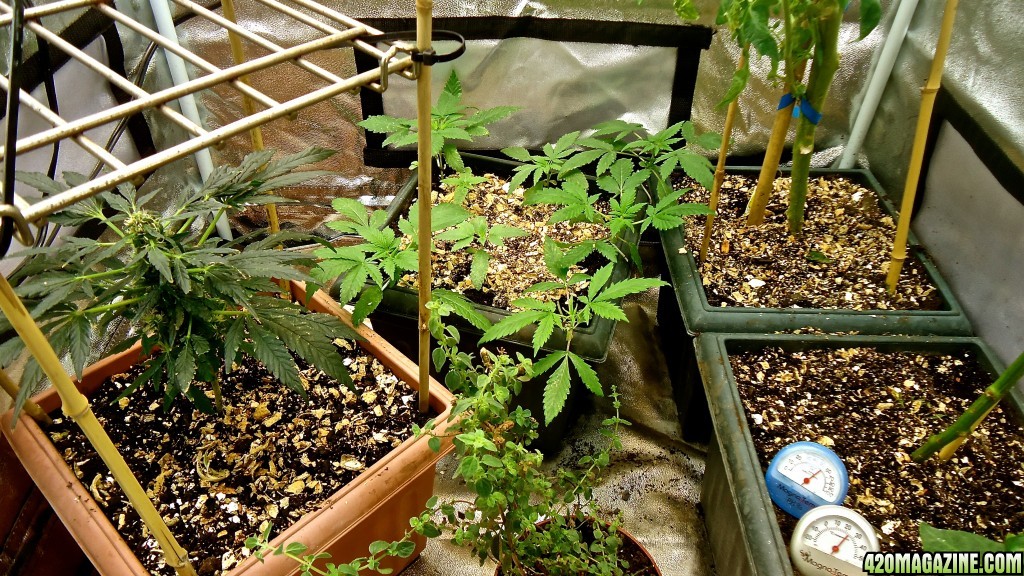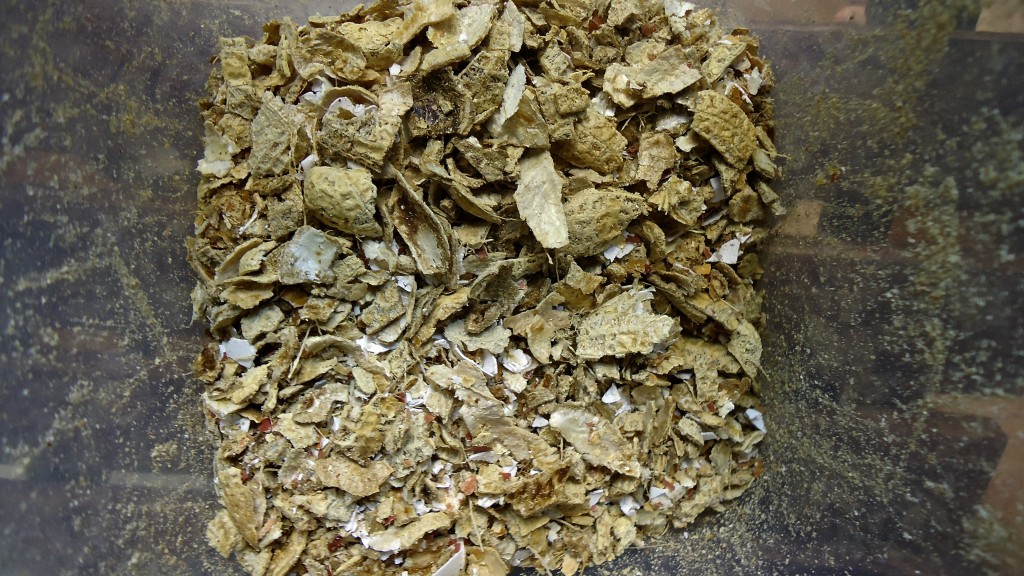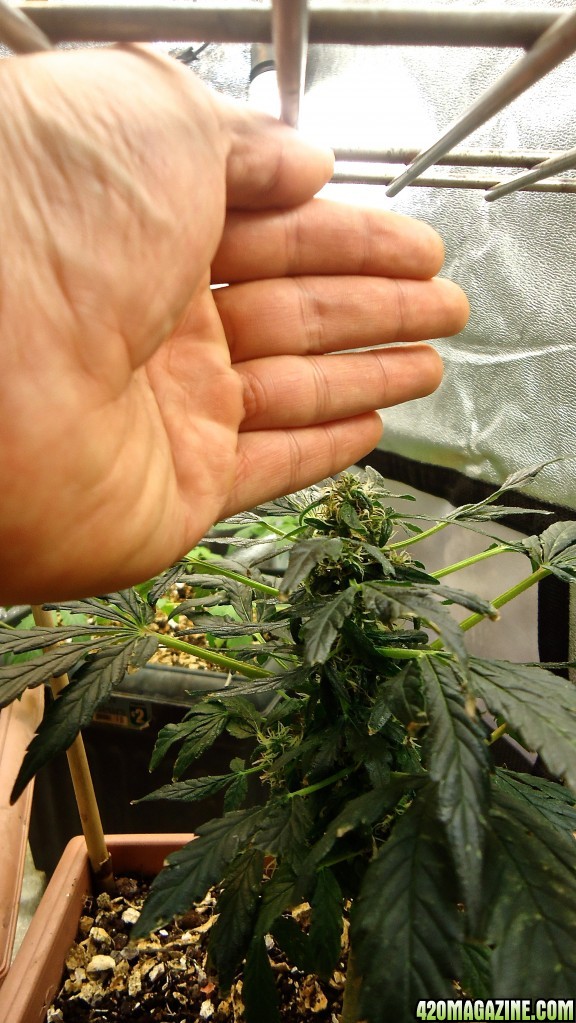I also want to post this extract of another reading where it explains a little what my Blue Berry is going thru... I believe she is hormonally at premature state of flowering;
Quote
"PREMATURE FLORAL STAGE
At this stage floral development is slightly beyond primordial and only a few clusters of immature pistillate flowers appear at the tips of limbs in addition to the primordial pairs along the main stems. By this stage stem diameter within the floral clusters is very nearly maximum. The stems are easily visible between the nodes and form a strong framework to support future floral development. Larger vegetative leaves (5-7 leaflets) predominate and smaller tri-leaflet leaves are beginning to form in the new floral axis. A few narrow, tapered calyxes may be found nestled in the leaflets near the stem tips and the fresh pistils appear as thin, feathery, white filaments stretching to test the surroundings. During this stage the surface of the calyxes is lightly covered with fuzzy, hair-like, non-glandular trichomes, but only a few bulbous and capitate-sessile glandular trichomes have begun to develop. Resin secretion is minimal, as indicated by small resin heads and few if any capitate-stalked, glandular trichomes. There is no drug yield from plants at the premature stage since THC production is low, and there is no economic value other than fiber and leaf. Terpene production starts as the glandular trichomes begin to secrete resin; premature floral clusters have no terpene aromas or tastes. Total cannabinoid production is low but simple cannabinoid phenotypes, based on relative amounts of THC and CBD, may be determined. By the pre-floral stage the plant has akeady established its basic chemotype as a fiber or drug strain. A fiber strain rarely produces more than 2% THC, even under perfect agricultural conditions. This indicates that a strain either produces some varying amount of THC (up to 13%) and little CBD and is termed a drug strain or produces practically no THC and high CBD and is termed a fiber strain, This is genetically controlled.
The floral clusters are barely psychoactive at this stage, and most cannabissmokers classify the reaction as more an "effect" than a "high." This most likely results from small amounts of THC as well as trace amounts of CBC and CBD. CBD production begins when the seedling is very small. THC production also begins when the seedling is very small, if the plant originates from a drug strain. However, THC levels rarely exceed 2% until the early floral stage and rarely produce a "high" until the peak floral stage.
EARLY FLORAL STAGE
Floral clusters begin to form as calyx production increases and internode length decreases. Tri-leaflet leaves are the predominant type and usually appear along the secondary floral stems within the individual clusters. Many pairs of calyxes appear along each secondary floral axis and each pair is subtended by a tri-leaflet leaf. Older pairs of calyxes visible along the primary floral axis during the premature stage now begin to swell, the pistils darken as they lose fertility, and some resin secretion is observed in trichomes along the veins of the calyx. The newly produced calyxes show few if any capitate-stalked trichomes. As a result of low resin production, only a slight terpene aroma and psychoactivity are detectable. The floral clusters are not ready for harvest at this point. Total cannabinoid production has increased markedly over the premature stage but THC levels (still less than 3%) are not high enough to produce more than a subtle effect.
PEAK FLORAL STAGE
Elongation growth of the main floral stem ceases at this stage, and floral clusters gain most of their size through the addition of more calyxes along the secondary stems until they cover the primary stem tips in an overlapping spiral. Small reduced mono-leaflet and tri-leaflet leaves subtend each pair of calyxes emerging from secondary stems within the floral clusters. These subtending leaves are correctly referred to as bracts. Outer leaves begin to wilt and turn yellow as the pistillate plant reaches its reproductive peak. In the primordial calyxes the pistils have turned brown; however, all but the oldest of the flowers are fertile and the floral clusters are white with many pairs of ripe pistils. Resin secretion is quite advanced in some of the older infertile calyxes, and the young pistillate calyxes are rapidly producing capitate-stalked glandular trichomes to protect the precious unfertilized ovule. Under wild conditions the pistillate plant would be starting to form seeds and the cycle would be drawing to a close. When Cannabis is grown for sinsemilla floral production, the cycle is interrupted. Pistillate plants remain unfertilized and begin to produce capitate -stalked trichomes and accumulate resins in a last effort to remain viable. Since capitate-stalked trichomes now predominate, resin and THC production increase. The elevated resin heads appear clear, since fresh resin is still being secreted, often being produced in the cellular head of the trichome. At this time THC acid production is at a peak and CBD acid levels remain stable as the molecules are rapidly converted to THC acids, THC acid synthesis has not been active long enough for a high level of CBN acid to build up from the degradation of THC acid by light and heat. Terpene production is also nearing a peak and the floral clusters are beautifully aromatic. Many cultivators prefer to pick some of their strains during this stage in order to produce cannabis with a clear, cerebral, psychoactive effect. It is believed that, in peak floral clusters, the low levels of CBD and CBN allow the high level of THC to act without their sedative effects. Also, little polymerization of resins has occurred, so aromas and tastes are often less resinous and tar like than at later stages. Many strains, if they are harvested in the peak floral stage, lack the completely developed aroma, taste and psychoactive level that appear after curing. Cultivators wait longer for the resins to mature if a different taste and psychoactive effect is desired.
This is the point of optimum harvest for some strains, since most additional calyx growth has ceased. However, a subsequent flush of new calyx growth may occur and the plant continue ripening into the late floral stage.
LATE FLORAL STAGE
By this stage plants are well past the main reproductive phase and their health has begun to decline. Many of the larger leaves have dropped off, and some of the small inner leaves begin to change color. Autumn colors (purple, orange, yellow, etc.) begin to appear in the older leaves and calyxes at this time; many of the pistils turn brown and begin to fall off. Only the last terminal pistils are still fertile and swollen calyxes predominate. Heavy layers of protec tive resin heads cover the calyxes and associated leaves. Production of additional capitate-stalked glandular trichomes is rare, although some existing trichomes may still be elongating and secreting resins. As the previously secreted resins mature, they change color. The polymerization of small terpene molecules (which make up most of the resin) produces long chains and a more viscous and darker-colored resin. The ripening and darkening of resins follows the peak of psychoactive cannabinoid synthesis and the transparent amber color of mature resin is usually indicative of high THC content. Many cultivators agree that transparent amber resins are a sign of high-quality drug Cannabis and many of the finest strains exhibit this characteristic. Particularly potent Cannabis from California, Hawaii, Thailand, Mexico, and Colombia is often encrusted with transparent amber colored instead of clear resin heads. This is also characteristic of Cannabis from other equatorial, subtropical and temperate zones where the growing season is long enough to accommodate long term resin production and maturation. Many areas of North America and Europe have too short a season to fully mature resins unless a greenhouse is used. Specially acclimatized strains are another possibility. They develop rapidly and begin maturing in time to ripen amber resins while the weather is still warm and dry.
The weight yield of floral clusters is usually highest at this point, but strains may begin to grow an excess of leaves in late-stage clusters to catch additional energy from the rapidly diminishing autumn sun. Total resin accumulation is highest at this stage, but the period of maximum resin production has passed. If climatic conditions are harsh, resins and cannabinoids will begin to decompose. As a result, resin yield may appear high even if many of the resin heads are missing or have begun to deteriorate and the overall psychoactivity of the resin has dropped. THC decomposes to CBN in the hot sun and will not remain intact or be replaced after the metabolic processes of the plant have ceased. Since cannabinoids are so sensitive to decomposition by sunlight, the higher psychoactivity of amber resins may be a secondary effect. It may be that the THC is better protected from the sun by amber or opaque resins than by clear resins. Some late maturing strains develop opaque, white resin heads as a result of terpene polymerization and THC decomposition. Opaque resin heads are usually a sign that the floral clusters are over-mature.
Late floral clusters exhibit the full potential of resin production, aromatic principles, and psychoactive effect. Complex mixtures of many mon oterpene and sesquiterpene hydrocarbons along with alcohols, ethers, esters, and ketones determine the aroma and flavor of mature Cannabis. The levels of the basic terpenes and their polymerized by-products fluctuate as the resin ripens. The aromas of fresh floral clusters are usually preserved after drying, as by the late floral stage, a high proportion of ripe resins are present on the mature calyxes of the fresh plant. Cannabinoid production favors high THC acid and rising CBN acid content at this stage, since most active biosynthesis has ceased and more THC acid is being broken down into CBN acid than is being produced from CBD acid. CBD acid may accumulate because not enough energy is available to complete its conversion to THC acid. The THC-to-CBD ratio in the harvested floral clusters certainly begins to drop as biosynthesis slows, because THC acid levels decrease as it decom poses, and at the same time CBD acid levels remain or rise intact since CBD does not decompose as rapidly as THC acid. This tends to produce cannabis characterized by more somatic and sedative effects. Some cultivators prefer this to the more cerebral and clear psychoactivity of the peak floral stage."







 I most certainly am doing some experimenting to keep myself busy during winter... Im really trying to understand photoperiods and how plants adapt to new environments.
I most certainly am doing some experimenting to keep myself busy during winter... Im really trying to understand photoperiods and how plants adapt to new environments. 


 Happy Freetheweed day.
Happy Freetheweed day. 








 :surrender:
:surrender:

 that talks about this. Guess I can take a hit on my plants if it doesn't work out, guess we will have to wait and see what ever comes out of this experiment.
that talks about this. Guess I can take a hit on my plants if it doesn't work out, guess we will have to wait and see what ever comes out of this experiment.
